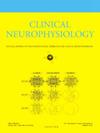听觉事件相关电位显示慢性轻度创伤性脑损伤与听觉和非听觉相关
IF 3.6
3区 医学
Q1 CLINICAL NEUROLOGY
引用次数: 0
摘要
目的听觉事件相关电位(ERP)可能反映重复性轻度创伤性脑损伤(mild TBI)的慢性效应,但听觉损伤对这些ERP变化的影响尚不清楚。方法我们比较了270名参战老兵(N = 270)的听力敏感性、复杂听觉加工和听觉皮质erp,这些老兵有和没有轻度TBI、战斗部署环境下的TBI、爆炸TBI、创伤后失忆症(PTA)、意识丧失和非TBI爆炸暴露。中介分析评估了创伤性脑损伤暴露次数对P50和N100振幅和潜伏期的听力、年龄和心理症状调节效应,以及erp是否在创伤性脑损伤和复杂听觉加工之间起中介作用。结果调整后,高暴露于战斗性和爆炸性脑损伤预测更大的P50振幅;轻度TBI合并PTA与P50潜伏期延长相关,P50潜伏期延长介导了噪声感知中的言语表达;战斗爆炸暴露(非创伤性脑损伤)与N100振幅降低有关。结论高强度爆炸暴露或战斗轻度创伤性脑损伤和爆炸暴露所观察到的听觉皮层反应变化与听觉功能障碍或当前的心理困扰无关。相比之下,轻度TBI与PTA预测听觉皮层反应与噪音下言语处理的行为后果。听觉P50和N100是轻度脑损伤对非听觉和听觉慢性脑功能影响的有希望的生物标志物。本文章由计算机程序翻译,如有差异,请以英文原文为准。
Auditory event-related potentials show both auditory and non-auditory associations with chronic mild traumatic brain injury
Objective
Auditory event-related potentials (ERP) may reflect chronic effects of repetitive mild traumatic brain injury (mild TBI), but the influence of auditory impairment on these ERP changes is unclear.
Methods
We compared hearing sensitivity, complex auditory processing, and auditory cortical ERPs in combat veterans (N = 270) with and without mild TBI, TBI in combat deployment setting, blast TBI, post-traumatic amnesia (PTA), loss of consciousness, and non-TBI blast exposures. Mediation analysis assessed the hearing, age, and psychological symptom-adjusted effect of number of TBI exposures on P50 and N100 amplitude and latency, and whether ERPs mediated between TBI and complex auditory processing.
Results
After adjustment, higher exposures to combat and blast TBI predicted larger P50 amplitudes; mild TBI with PTA was associated with longer P50 latency, which mediated speech in noise perception; combat blast exposures (non-TBI) were associated with reduced N100 amplitude.
Conclusion
Auditory cortical response changes observed for higher exposure to blast or combat mild TBI and blast exposures were not attributable to auditory dysfunction or current psychological distress. In contrast, mild TBI with PTA predicted auditory cortical responses with behavioral consequences for speech processing in noise.
Significance
Auditory P50 and N100 are promising biomarkers for both the non-auditory and auditory chronic effects of mild TBI on brain function.
求助全文
通过发布文献求助,成功后即可免费获取论文全文。
去求助
来源期刊

Clinical Neurophysiology
医学-临床神经学
CiteScore
8.70
自引率
6.40%
发文量
932
审稿时长
59 days
期刊介绍:
As of January 1999, The journal Electroencephalography and Clinical Neurophysiology, and its two sections Electromyography and Motor Control and Evoked Potentials have amalgamated to become this journal - Clinical Neurophysiology.
Clinical Neurophysiology is the official journal of the International Federation of Clinical Neurophysiology, the Brazilian Society of Clinical Neurophysiology, the Czech Society of Clinical Neurophysiology, the Italian Clinical Neurophysiology Society and the International Society of Intraoperative Neurophysiology.The journal is dedicated to fostering research and disseminating information on all aspects of both normal and abnormal functioning of the nervous system. The key aim of the publication is to disseminate scholarly reports on the pathophysiology underlying diseases of the central and peripheral nervous system of human patients. Clinical trials that use neurophysiological measures to document change are encouraged, as are manuscripts reporting data on integrated neuroimaging of central nervous function including, but not limited to, functional MRI, MEG, EEG, PET and other neuroimaging modalities.
 求助内容:
求助内容: 应助结果提醒方式:
应助结果提醒方式:


